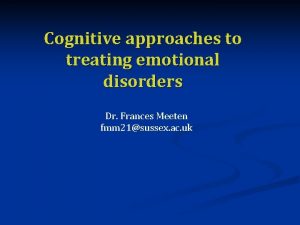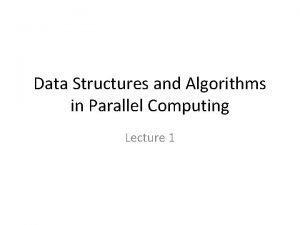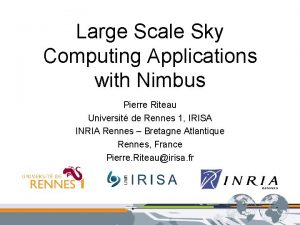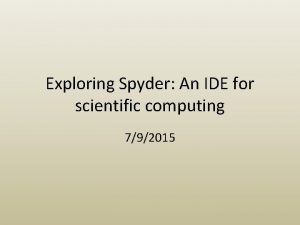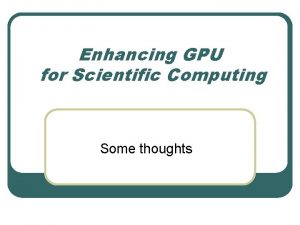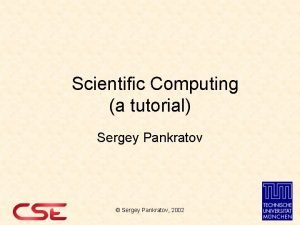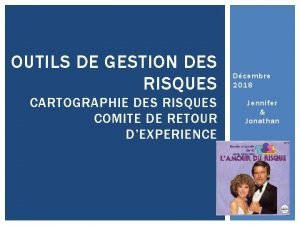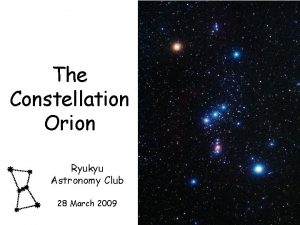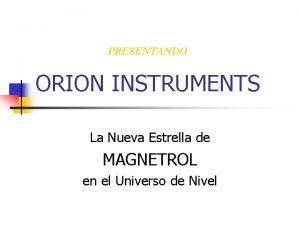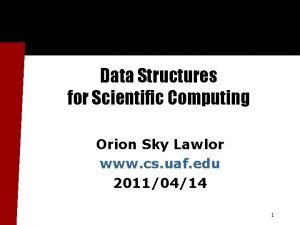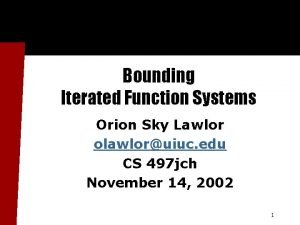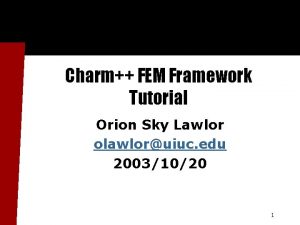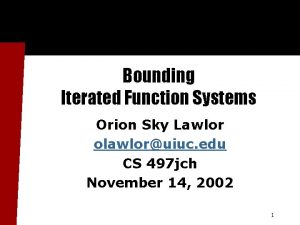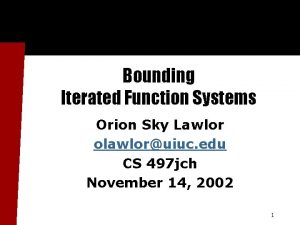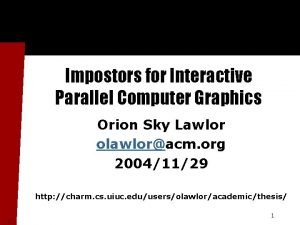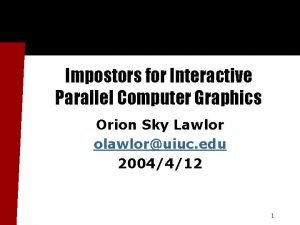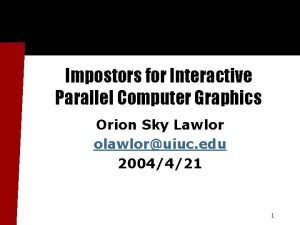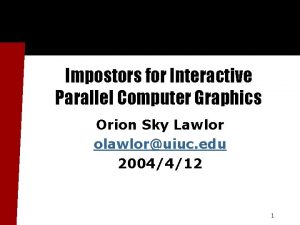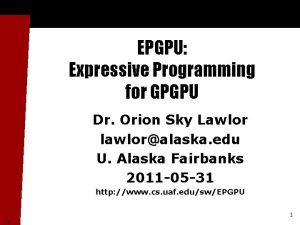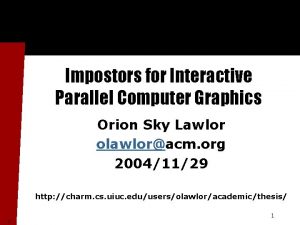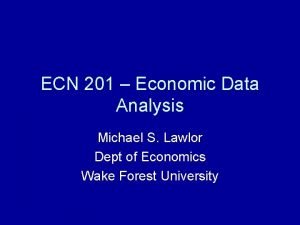Data Structures for Scientific Computing Orion Sky Lawlor





























- Slides: 29

Data Structures for Scientific Computing Orion Sky Lawlor charm. cs. uiuc. edu 2003/12/17 1

Overview Introduction and Motivation n Structured Grids n n n Unstructured Grids n n Adaptive structured grids Adaptive unstructured grids Particles and Spatial Search Regular grids n Trees n 2

Introduction / Motivation n There are only a few ways to represent the problem domain: Structured Grids n Unstructured Grids n Particles n This set covers all our grants! n Knowing the basic terms helps you talk to application folks, and understand their stuff n 3

Grids in General 4

Grids: Introduction So you’re trying to represent some physical situation, like heat flow n You decide to divide up space into a bunch of little pieces: n Node, Vertex, Point Element, Cell, Volume 5

Grids: Location of Data n Element Centered Data n Fluid Dynamics, most PDEs Data values constant (or simple) in a cell n Node Centered Data n Structural dynamics/FEM “Shape function” interpolates between nodes 6

Grids: Motion of Grid and Data n Eulerian: non-moving grid n n E. g. , pressure waves move through the grid in CFD Lagrangian: moving grid n E. g. , grid deformation follows the structure deformation in FEM 7

Structured Grids 8

Structured Grids: Introduction n AKA “Regular Grid”, since grid cells lie in regular rows and columns Cells are stored in a 3 D array Cells can lie along axes (“rectilinear grid”); or curve through space Y X 9

Structured Grids: Terminology n “Stencil” of source cells to compute a destination cell Common in fluid dynamics n Also found in PDE solvers n n j x i Read-only “Ghost” or “Dummy” cells around boundary j i 10

Structured Grids: Applications n Fluid Dynamics n n Jacobi and other PDE solvers n n CPSD (Danzig) Image processing n n “Finite Difference” formulation Level set methods n n CSAR’s Rocflo (Jiri Blazek) Just a 2 D pixel array! Charm++ Multiblock Framework 11

Adaptive Structured Grids 12

Adaptive Structured Grids: Intro n n n “Adaptive Mesh Refinement”/AMR Cells are stored in small 3 D arrays, linked together with pointers For regular refinement, use quadtree (2 D) or octree (3 D); can be irregular “block structured AMR” from LLNL SC 98 SAMRAI flier 13

Adaptive Structured Grids: Terms n “Refinement” and “Coarsening” criteria control evolution of mesh n n Basically simulation error estimates “Hanging Node Constraint” n Neighbors must have similar (± 1) refinement level bad! 14

Adaptive Structured Grids: Apps n Adaptive physics solvers n CPSD Dendritic Growth (Danzig) • Octree-based 3 D fluids code LLNL SAMRAI C++ Framework n NASA GSFC PARAMESH n AMRITA (James Quirk) n Charm++ AMR Framework (Narula, Jyothi) n 15

Unstructured Grids 16

Unstructured Grids: Introduction n n AKA “Mesh” Cells are stored in 1 D array Vertices (“nodes”) of cells (“elements”) listed explicitly Mesh consists of triangles and/or quadrilaterals (2 D); tetrahedra, cubes/hexahedra, prisms, pyramids (3 D) 17

Unstructured Grids: Terms n “Ghosts”, like structured grids “Shared nodes” along partition boundaries--see FEM manual n “Conformality” n n Nodes never land in middle of element bad! 18

Unstructured Grids: Applications n Structural Mechanics n n Fluid Dynamics n n CSAR’s Rocflu (Haselbacher) Even Adaptive Meshes! n n CSAR’s Fractography (Geubelle) CPSD Dendritic Growth (Danzig) Charm++ FEM Framework (Lawlor) 19

Adaptive Unstructured Grids 20

Adaptive Unstructured Grids: Intro n n n AKA “Mesh Refinement”, shades into from-scratch “Mesh Generation” Cells still stored in 1 D arrays, but the cells can now change Must respect conformality Must ensure element “quality” Must work in parallel 21

Adaptive Meshes: Terminology n “Delaunay” mesh and “flip” n “Edge bisection”: cut edge in middle 22

Adaptive Meshes: Applications n Every unstructured mesh program wants to be adaptive n CSAR, CPSD, etc. . . Charm++ Triangle Mesh Refinement (Wilmarth) n Charm++ PMAF 3 D (Wilmarth) n Charm++ Tet Data Transfer Library (Lawlor) n 23

Particle Methods and Spatial Search 24

Particles and Spatial Search n To work on a particle, you need nearby particles n E. g. , all particles within cutoff r • Used by NAMD n or, all k nearest particles • Used by SPH methods n Search for neighboring particles is spatial, so need a spatial search structure n Can use: structured grid, adaptive search tree, unstructured grid, . . . 25

. . . using Structured Grids n E. g. , NAMD molecular dynamics Particles are Atoms n Search structure is based on “Patches” of space in regular, rectilinear grid n atoms over here. . . n . . . never talk to atoms over here E. g. , Charm++ Collision Library n Search structure is based on regular rectilinear voxel grid 26

. . . using Search Trees n E. g. , Cosmology simulations Particles are stars, galaxies n Search structure is a spatial octree n SPH: “Smoothed particle hydrodynamics” n Barnes-Hut gravity n “Tree walk” n 27

Conclusions 28

Conclusions n There are only a few ways to represent the problem domain: Structured Grids n Unstructured Grids n Particles n n There a lot of specialized terms, but very few concepts 29
 Gerry lawlor
Gerry lawlor Dr colleen lawlor
Dr colleen lawlor Dr frances lawlor
Dr frances lawlor Data structures for parallel computing
Data structures for parallel computing Blue sky computing
Blue sky computing Sky computing
Sky computing Give other examples of homologous structures
Give other examples of homologous structures Virtualization structures/tools and mechanisms
Virtualization structures/tools and mechanisms Conventional computing and intelligent computing
Conventional computing and intelligent computing Eclipse ide for scientific computing
Eclipse ide for scientific computing Best gpu for scientific computing
Best gpu for scientific computing Scientific computing tutorial
Scientific computing tutorial Scientific inquiry vs scientific method
Scientific inquiry vs scientific method How is a scientific law different from a scientific theory?
How is a scientific law different from a scientific theory? Greek god orion
Greek god orion Orion unillanos
Orion unillanos Constellation dorion
Constellation dorion Orion alpha a28f
Orion alpha a28f Diagramme de farmer cartographie des risques
Diagramme de farmer cartographie des risques Fiware context broker
Fiware context broker Orion
Orion Methode orion
Methode orion Orion philosophy
Orion philosophy Zojm wrocław
Zojm wrocław Orion context broker
Orion context broker Orion
Orion Bold orion
Bold orion Magnetrol caldera
Magnetrol caldera Orion
Orion Inclisiran
Inclisiran


